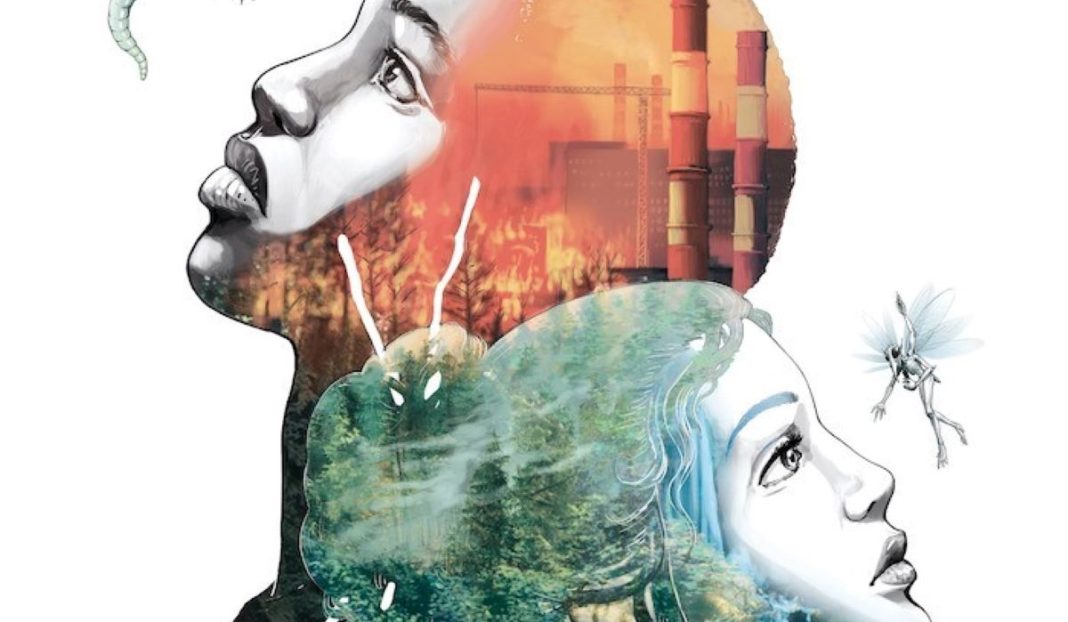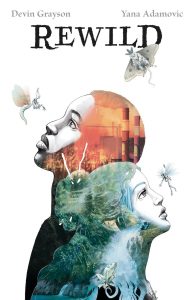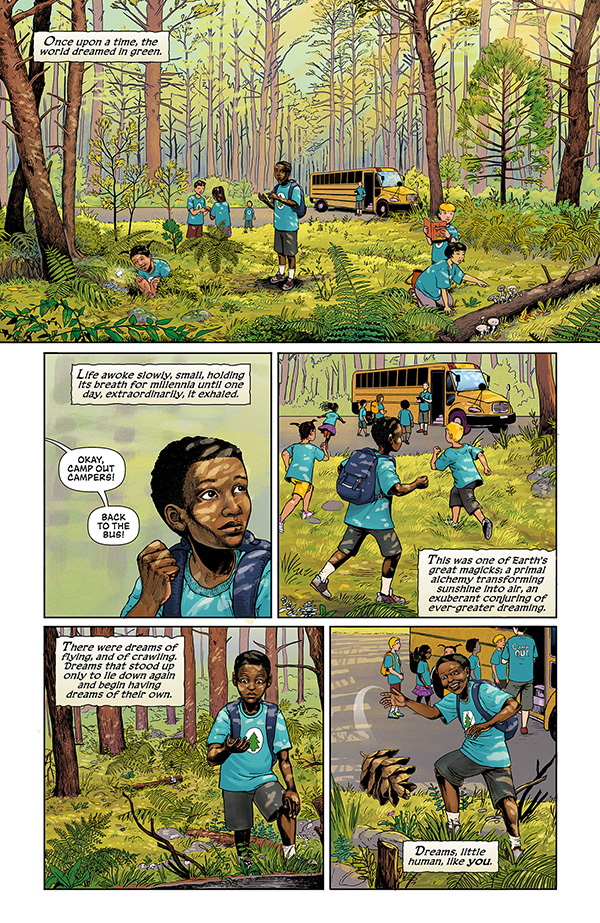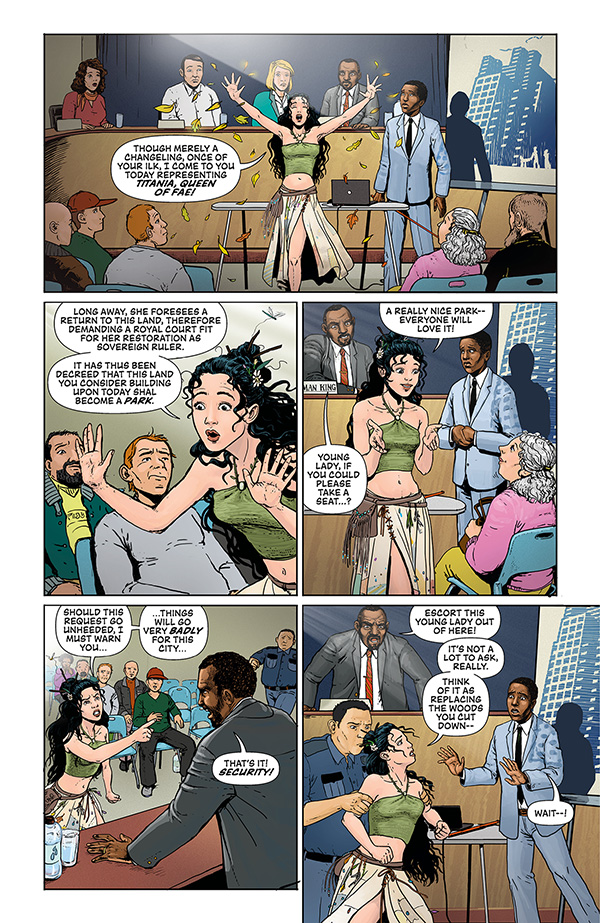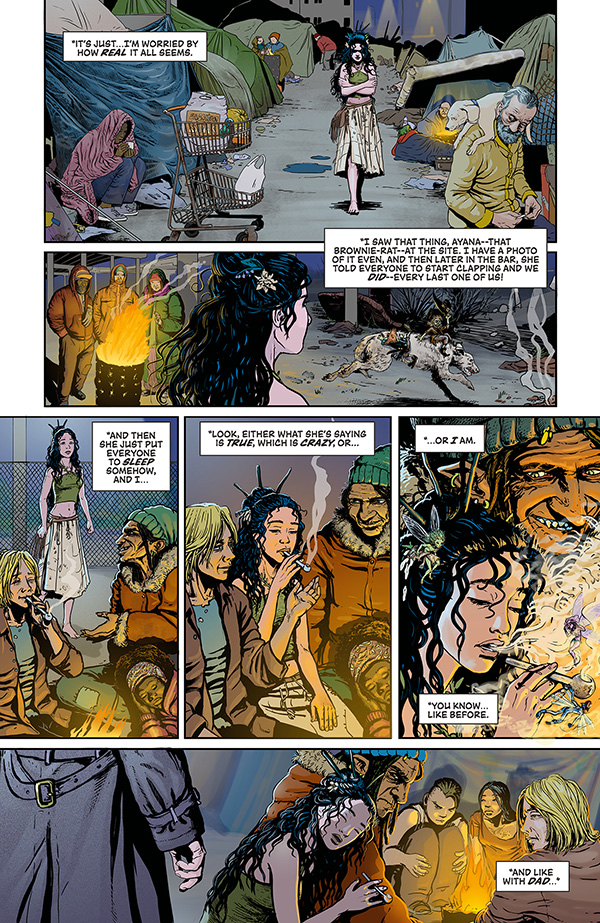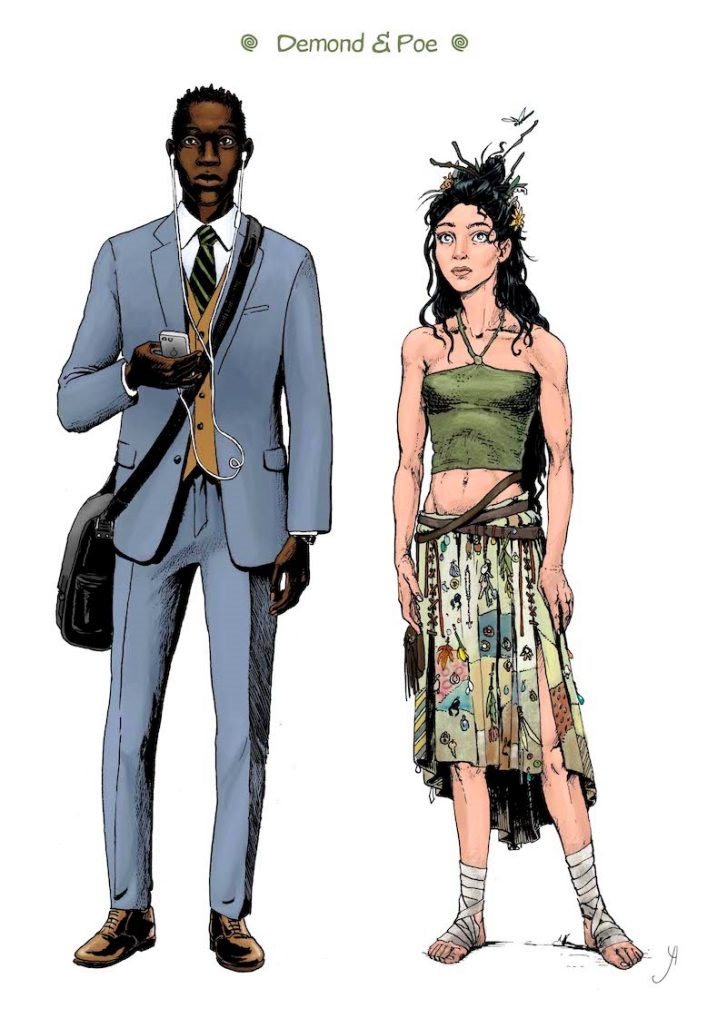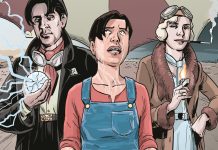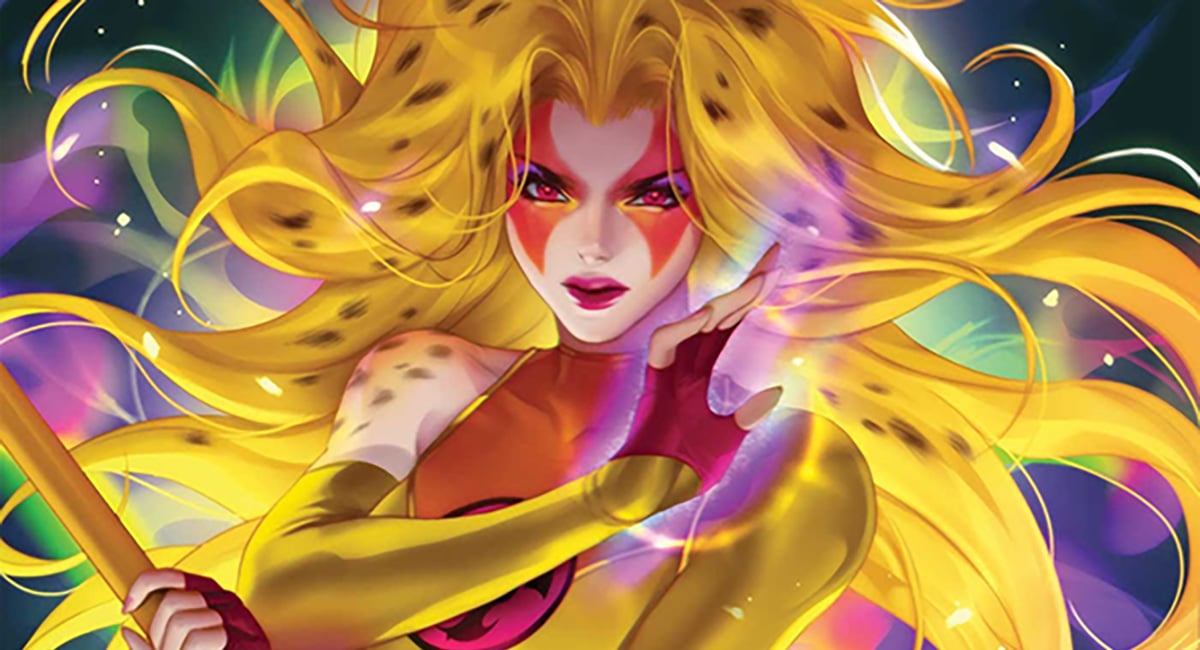Devin Grayson teams up with artist Yana Adamovic for Rewild, a new graphic novel from Dark Horse’s Berger Books imprint. The book presents a magical realist tale that tackles the impending doom of climate change in its own unique way – featuring a heady mix of fae and fable.
With the wide release of Rewild, Grayson took time out of their schedule to speak with The Beat about the new book, its genesis and the importance of stories in helping us connect to overwhelming real world crises.
Dean Simons: In Rewild, the link between humanity and the environment throughout history, and that in turn influencing the world of fae, is an interesting one. Can you take us back to when the idea initially formed – how long ago did it happen? Was the final executed idea the same as the initial one? What changed in the genesis?
Devin Grayson: Where I live in Northern California, the link between humanity and the environment—perhaps better described as an interdependency—is increasingly inescapable. At its deepest level, that’s really what the story of Rewild is about: the complete lack of separation between our lives and the places in which we live them. This is a theme I’ve been thinking about for most of my life, with the central question always being some version of: what will it take to make people understand that we’re of rather than on this planet? But I think the narrative of Rewild began first taking shape during the Camp Fire of 2018. For those of us living in California, that was a shocking reminder of the vulnerability of our landscape. And although the Camp Fire was eventually contained, it was also a precursor to a still growing succession of horrific annual “fire seasons,” that obliterated any sense of safety that I and many of my fellow Californians had previously been able to delude ourselves into feeling.
The fae in Rewild exist to give nature, and its subsumption of us, a voice. It seems to me that many of our mythologies around fairies speak to our misconceptions about our relationship with the wild. As a species, we have a tendency to both personify and “other” the things we encounter, categorizing everything—the planet, other species, even each other–as distinct and separate from our existence, when of course the truth is precisely the opposite. It’s like that brilliant Yasutani Roshi quote: “The fundamental delusion of humanity is to suppose that I am here and you are out there.” Rewild is one of many attempts to wear away that delusion.
As a story examining our inaction in the face of the existential threat of the Climate Crisis, Rewild always contained musings on collective insanity. But I think one of the pieces of the story that grew and developed as I wrote—in large part due to Karen Berger’s influence—was the role individual mental health plays in that. Demond’s personal and familial struggle in the story allow us to represent and acknowledge some of the (many) obstacles to personal action a would-be activist faces. In addition to touching on self-doubt, intergenerational trauma, and incarceration, Demond’s story ends up echoing the gripping question Johanna Hedva raises in her article “Sick Woman Theory”: “How do you throw a brick through the window of a bank if you can’t get out of bed?”
Simons: Why did you turn to the world of fable and fae for engaging with the Climate Crisis?
Grayson: Generally speaking, I’m not usually attracted to the fantasy genre. Our lives are so rich and complex and made up of so many underexplored layers, that throwing superpowers or supernatural elements into stories often feels like overkill to me. But by that same token, we often end up needing allegory of one sort or another in order to articulate and focus in on those complexities.
Part of what people find difficult to grasp about Climate Change is that it isn’t a singular event. We’re not going to wake up one morning and be told that we have X hours to live. On the one hand, we wake up every morning being told pretty much exactly that by very freaked out scientists who don’t understand why we’re not listening, but on the other, what we’re facing is a disaster unfolding in ecological time, in which every change we fail to make today has horrific repercussions that will continue to play out, and multiply, and worsen, and merge into feedback loops with one another, for the next several decades if not centuries. We need to act right now, so in fiction, when we have the opportunity to move you through the problem emotionally instead of logically, we often take advantage of the opportunity to show it all happening at once.
In terms of turning to fae and fairy tales specifically, I think the historical connection between fae and the natural world made them an obvious choice, as the threatening, moral nature of classic fairy tales and fables made the genre very fertile for this kind of story. The presence of fairies also takes many of us back to childhood, and although Rewild is by no means a children’s story, I do want readers to remember that they once spoke to trees and flowers and the ocean and instinctively understood their kinship to those things.
Simons: Can you give us some insight into your research toward the book – both with climate change and the fantastical aspects? Any recommendations?
Grayson: For the fantasy aspect of it, I primarily leaned on the material I grew up with: Grimms’ Fairy Tales, Shakespeare (Titania and her crew being obviously borrowed from A Midsummer Night’s Dream), and Rien Poortvliet and Wil Huygen’s amazing Gnomes book, which was a reference Yana and I shared. And because so much of that was seeped in Western European mythology and I wanted Rewild to be global, I encouraged Yana to include legends from her corner of the world and made a conscious effort to incorporate mythological creatures from other cultures. There are so many we didn’t have space for—I would have loved to have had a Curupira, for example, but didn’t learn of them until after Yana’s gorgeous art was in—but I adore the ones we did manage to include, from the terrifying Inkanyamba to the delightful squonk.
For the Climate Crisis piece, I read and listened to everything I could get my hands on which, honestly, left me hugely depressed, but also galvanized. Of the books, I’d strongly recommend All We Can Save, an anthology of essays and poems edited by Drs. Ayana Elizabeth Johnson & Katharine K. Wilkinson, Elizabeth Kolbert’s The Sixth Extinction, and David Wallace-Wells’ The Uninhabitable Earth. I also love the How to Save a Planet podcast by Gimlet Media, and highly recommend Sir David Attenborough’s Netflix series, Our Planet. The BBC’s Climate Change: The Facts is also quite powerful and succinct.
Simons: How did you bring Yana Adamovic onboard this project? Did you know Yana beforehand?
Grayson: I had the terrific good fortune of meeting Yana at Barcelona International Con 2019, where I was one of ECC’s special guests for the show. We hit it off on a personal level immediately, but then one evening she brought one of the projects she’d done with French comic publisher Delcourt Editions to dinner to share with everyone, and it was utterly amazing. The first page I saw was a spread of an Ancient city from the Ottoman Empire, and it was so full of detail and warmth that, even without being able to read a word of the text, I was instantly pulled into the story.
And that first impression held. Yana is such an amazing person and artist, and I’m so thrilled to help bring her work in front of an American audience. Yana is from Belgrade, Serbia, speaks three languages fluently, has an MA from the Faculty of Applied Arts in Belgrade, and was knighted in 2019 by the French Minister of Culture. She loves fairies and has a beautiful young son for whom she of course wants a healthy and vibrant future, so she threw herself into this project with such grace and passion, and I think her commitment shows on every page. The art in Rewild is incredibly lovely and engaging. The pages brim with stories that add so much dimension to the world we created.
Simons: How did you get involved with Berger Books? Was Rewild the first thing you pitched for the imprint?
Grayson: It was, yes. I’d worked with Karen peripherally back at Vertigo when I wrote USER, but hadn’t gotten the chance to engage with her directly back then. It was immediately obvious to me how much she could help with a story like Rewild, though, so Berger Books was the first and only place to which we pitched.
Karen was very much the third member of our team and helped so much with crucial elements like keeping the story grounded in the characters and encouraging me to let the history of our human characters have as much history and breadth as those of our immortal ones. I encountered two main challenges while scripting and she was so incredibly helpful with both. The first was that I kept getting overwhelmed with wanting to share all the facts and calls to action that I was learning as I continued researching the Climate Crisis. And although a lot of what I picked up was compelling in its own right, most of it didn’t belong in the story in its current incarnation. Karen was always able to bring me back to the narrative spine of the story and its central emotional conflicts, which really becomes the difference between a solid story and a failed treatise. Secondly, I lost my mom to cancer quite suddenly between the third and fourth chapter. In a lot of ways, I’d been writing the book for her, so to lose her as well as the possibility of sharing it with her was really devastating. Both Karen and Yana were so understanding about my temporary paralysis and so good about keeping the momentum of our production moving while I grieved. I’m still not entirely sure how I managed to finish the script on time, but I know that it was in large part due to their patience and compassion. I really came to love them both dearly over the course of this project and feel honored to call them friends. And I’m so proud that we have Rewild—which also greatly benefits from the energy and talents of Sal Cipriano, Rae Boyadjis, and Richard Bruning—as a lasting testament to the power of our collaboration.
Simons: It seems the book was originally going to be published in single issues, did the change to a trade-only release affect you much? Would you have approached Rewild differently?
Grayson: I imagined the story as a graphic novel from the start. The tack toward single issues was an initial requirement of Berger Books that fell away in response to pandemic-related publishing challenges. It’s always useful to think of a story as a series of acts, though, so moving from graphic novel to single issues and then back to graphic novel again wasn’t as disruptive as one might imagine, it just challenged my pacing skills a little. My only sadness about moving away from single issues was that we lost the opportunity to showcase more amazing covers from Yana. But ‘Rewild-the-Graphic-Novel’ is the story I set out to tell from the start, and I’m pleased to be able to present it in its intended form.
Simons: Where do you feel creativity and fiction sit in the face of such a daunting existential issue as the Climate Crisis?
Grayson: I think they’re essential. Our brains have evolved to derive meaning out of stories, or perhaps, even more precisely, to store meaning in them—we’re constantly constructing narratives in our heads to shape and hold our understanding of the world. A threat like Climate Change is so multifaceted and daunting, we need creative ways of bringing it into focus and locating our place in the story. I worry that the superhero genre has failed us in this respect; though many superhero stories are intended to inspire, most of them deal in a kind of exceptionalism that both romanticizes solitary action and encourages passive spectating. Even in team books, there’s often some kind of “us” against “them” undercurrent. And where the Climate Crisis is concerned, no one is coming to save us. There are no solutions that involve one brilliant or courageous or exceptionally skilled individual solving everything. Similarly, there is no “them” in the Climate Crisis—it’s all us. The heroes are us, the villains are us, the problem is us, and the solutions are us. The story of the Climate Crisis is our story, completely, and we need to own it. So we need stories that reconnect us to nature and the environments in which we exist. We need stories that remind us how much we care about each other, and every living thing on this planet. We need stories that engage us as protagonists rather than observers.
Simons: There is a certain hopelessness and weight of human intransigence in the narrative, and Rewild ends on a rather abrupt note, was that always intended? What do you hope readers to take away from it?
Grayson: It was always intended, though I’ll admit to struggling with my intention during the creation of the book. As I discuss in the afterword, the story arose from feelings of desperation and grief as I watched my state burn. I didn’t feel I was in the position to put forward solutions and I didn’t want to offer unearned hope, but of course I also didn’t want to leave people feeling hopeless and inert. What I did feel I could manage was an emotionally convincing argument for empathy and connection, as well as the creation of space for collective grief—the kind of grief we need to move through before we can recommit to action.
I hope the story pulls readers back into a feeling of integration and connectedness with the natural world and leaves them clear about their roles as protagonists in this very real drama.
Simons: After Rewild, would you do more work in this vein or do you think you have already said all you felt needed?
Grayson: The research that I did for Rewild has left me pretty obsessed—there’s so much yet to do and therefore so much more to say. But Yana and I are already working on our next project, which is about internalized misogyny. I guess the broader theme I’m exploring these days is the question of why we’ve stopped believing in our power and responsibility to make things better. I’ve always been interested in the gap between knowing what needs to be done and doing it, and these days I’m feeling confident enough in my writing to use stories as a way to help people traverse it.
Rewild is available from all good comic shops now and arrives book stores January 11.


